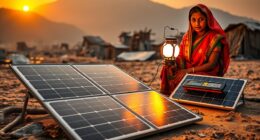Preppers in 2025 are preparing for a range of challenges: climate-related disasters, economic instability, technological threats, and health crises. These future trends necessitate a holistic readiness approach amidst uncertainties. From changing climate patterns demanding detailed disaster plans, to economic uncertainty prompting financial resilience through savings and bartering, to cybersecurity readiness against potential disruptions, preppers are prioritizing preparedness. Health crisis proactive measures, food supply challenges, sustainable practices, and skill development are also key areas of focus in anticipating and managing the complexities of the year 2025. There's much more insight into these trends for those interested.
Key Takeaways
- Rising temperatures and extreme weather events
- Transition to renewable energy sources
- Economic instability and inflation concerns
- Technological security against cyber threats
- Health crisis readiness and food supply challenges
Changing Climate Patterns
With changing climate patterns, preppers are actively preparing for more frequent and severe weather events. The rising temperatures and shifting precipitation patterns pose a significant challenge to disaster preparedness efforts. Disruptions in food production and water availability are key concerns for preppers, who must anticipate the need for thorough adaptation strategies to cope with extreme heatwaves, droughts, and floods.
The increased risk of natural disasters such as hurricanes, wildfires, and storms further underscores the necessity for advanced preparedness measures.
Climate change impacts on agriculture and infrastructure require preppers to enhance their resilience and self-sufficiency. In light of these challenges, preppers are focusing on developing detailed disaster preparedness plans to mitigate the potential impacts of changing climate patterns. By staying informed about weather trends, investing in emergency supplies, and honing survival skills, preppers are gearing up to navigate the uncertainties brought about by shifting climate patterns.
Economic Instability

Preppers actively anticipate economic instability by preparing for potential downturns and inflation in response to rising costs of goods and services in the United States.
The looming threat of economic instability may result in job losses, income reductions, and heightened financial strain on households. To combat these challenges, preppers are focusing on bolstering financial resilience through savings, investments, and reducing debt in anticipation of economic uncertainties.
Additionally, preppers are increasingly turning to bartering and trading goods as a means to navigate the potential disruptions in the economy. Stockpiling essential items and establishing sustainable income streams are key strategies being employed by preppers to fortify themselves against the ramifications of economic instability.
Technological Disruptions

Prepare for potential technological disruptions that may impact critical infrastructure and daily communication systems. Here are four key points to keep in mind:
- Cyberattacks on Critical Infrastructure:
Preppers are bracing for the possibility of cyber intrusions targeting essential systems like power grids and water supply networks. This could lead to widespread chaos.
- Internet Outages and Communication Disruptions:
The looming threat of grid failures and internet blackouts poses a risk to seamless communication channels. This could hinder access to important information during emergencies.
- Supply Chain Disruptions:
Technological failures have the potential to disrupt supply chains, jeopardizing the availability of essential goods like food and medical supplies. This prompts preppers to stockpile resources.
- Hacking Incidents and Digital Vulnerabilities:
With increased reliance on digital platforms, preppers are wary of potential hacking incidents that could disrupt daily life. This emphasizes the need for robust cybersecurity measures to safeguard against such threats.
Health Crisis Preparedness

In anticipation of potential health crises, individuals are proactively stocking up on medical supplies and exploring strategies to enhance their immune system health. Preppers are creating their version of a 'prepper pantry,' which includes essential medical supplies, medications, and personal protective equipment. Emphasis is placed on boosting immunity through nutrition, herbal remedies, and vitamins to fortify the body against potential illnesses.
These health crisis preparedness strategies extend to setting up isolation areas within homes, establishing communication plans, and staying informed about health guidelines. Preppers are also delving into alternative healthcare options, utilizing telemedicine services, and incorporating natural remedies for self-care during emergencies.
Mental health support, stress management techniques, and community resources are integral parts of the preparedness plan to enhance resilience during health crises.
Food Supply Challenges

Global challenges in the food supply chain are intensifying due to various factors like climate change, extreme weather events, and disruptions caused by pandemics.
To address these issues, preppers are taking proactive steps to secure their food security. Here are four key strategies they're implementing:
- Long-Term Food Storage: Preppers are stockpiling essential items like non-perishable foods to prepare for potential food shortages.
- Gardening: Growing their own fruits and vegetables allows preppers to supplement their food supply and reduce reliance on external sources.
- Homesteading: Some preppers are embracing self-sufficiency by raising livestock and cultivating crops on their properties.
- Food Preservation Techniques: Canning, dehydrating, and freezing food items enable preppers to extend the shelf life of perishable goods and mitigate the impact of disruptions in the food supply chain.
Security and Defense Strategies

When contemplating security and defense strategies, it's crucial to begin with a thorough threat assessment. This entails evaluating potential risks and vulnerabilities in your environment.
Subsequently, implementing tactical training techniques can assist you and your loved ones in being better prepared to handle various security challenges that may arise.
Threat Assessment Measures
Enhancing your security and defense strategies as a prepper involves fortifying your home, investing in surveillance systems, and developing emergency communication plans for potential threats in 2025.
When considering threat assessment measures, there are essential tools you should utilize:
- Conduct Regular Risk Assessments: Evaluate potential vulnerabilities in your security setup to proactively address weaknesses.
- Utilize Threat Monitoring Software: Employ advanced technology to monitor for any suspicious activities or potential threats in real-time.
- Gather Intelligence: Stay informed about the latest developments in your area to assess the level of risk accurately.
- Collaborate with Community Networks: Establish connections with other preppers and local groups to share information and enhance collective security measures.
Tactical Training Techniques
Conducting tactical training techniques is key for preppers looking to bolster their security and defense strategies in preparation for potential threats in 2025. Tactical training encompasses a range of skills vital for navigating uncertain times. Preppers focus on honing self-defense abilities, mastering firearms proficiency, and enhancing situational awareness to effectively handle potential threats. The primary goal is to secure and defend one's property, family, and resources during crisis situations. Through drills, simulations, and exercises, preppers simulate real-life scenarios to improve their response capabilities. By developing a well-rounded skill set, preppers aim to address security concerns comprehensively and protect themselves in varied and challenging circumstances.
| Tactical Training Techniques | Importance |
|---|---|
| Self-Defense Skills | Vital for personal protection and defense |
| Firearms Proficiency | Essential for handling and using firearms |
| Situational Awareness | Crucial for identifying and responding to threats |
| Property Defense | Protecting assets and securing living spaces |
| Crisis Response Capabilities | Improving readiness for emergency situations |
Self-Sufficiency Practices

To bolster your preparedness for potential disruptions, preppers are actively embracing self-sufficiency practices such as gardening, raising livestock, and food preservation. This shift towards self-reliance stems from a desire to reduce reliance on external resources, including the grocery store.
Here are four key aspects of self-sufficiency practices preppers are focusing on:
- Renewable Energy Sources: Increasing interest in utilizing renewable energy like solar power and wind turbines for sustainable living and long-term self-sufficiency goals.
- Water Management: Implementing rainwater harvesting techniques to secure water supply and reduce dependence on traditional sources.
- Composting: Utilizing composting methods to recycle organic waste into nutrient-rich soil for gardening and farming needs.
- Essential Skill Development: Acquiring skills in food production, renewable energy utilization, and other self-sufficiency practices to enhance resilience in the face of potential emergencies.
Frequently Asked Questions
What Do Doomsday Preppers Prepare For?
Doomsday preppers prepare for a range of catastrophic events such as nuclear war, economic collapse, pandemics, and natural disasters. They prioritize self-sufficiency by stockpiling essentials like food, water, and supplies, and honing survival skills.
Preppers anticipate disruptions to normal life, planning for long-term emergencies that could strain resources. Their preparations often involve securing shelter, self-defense weapons, medical supplies, and alternative energy sources to remain resilient in societal breakdowns and unforeseen disasters.
How Many Americans Are Preppers?
How many Americans are preppers? Studies indicate that a significant portion, around 51%, have supplies for emergency situations. Motivated by worries about natural disasters, 57% of Americans are taking steps to prepare.
The number of households stockpiling emergency supplies has risen by 40% in recent years. Approximately 41% of Americans have made preparations for potential emergencies.
A majority, 65%, believe in the importance of having a stockpile of supplies for unforeseen events.
What Should I Have as a Prepper?
As a prepper, you should prioritize essential items like:
- Food reserves
- Water storage
- First aid supplies
- Tools
- Communication devices
Develop a detailed emergency plan detailing:
- Evacuation routes
- Meeting points
- Communication protocols
Acquire basic survival skills such as:
- Fire-starting
- Shelter-building
- Foraging
- Self-defense
Consider investing in:
- Alternative energy sources like solar panels or generators for long-term sustainability
Building a community network with fellow preppers can provide:
- Crucial support
- Resources
- Resilience during crises
How Much Does the Average Prepper Spend?
When it comes to prepping, the average prepper typically spends between $400 and $500 per month on supplies and food storage. This investment may account for 10-20% of their monthly income.
Annually, prepping expenses can vary from $2,000 to $6,000, depending on the desired level of preparedness. Factors like family size, location, and specific emergency scenarios play an important role in determining these costs.
Quality over quantity is often prioritized for long-term food storage and emergency supplies.
What Are the Future Trends Preppers Should Be Preparing for in 2025?
As we look to the future, preppers should be preparing for various trends in 2025. With the increasing concern over natural disasters and global crises, investing in quality preppers supplies for sale will be crucial. From renewable energy sources to sustainable food storage, a well-rounded approach is essential for any prepper.
Conclusion
Prepare yourself for the future by being proactive in planning for potential challenges. Stay ahead of the game and safeguard your safety and well-being by considering the changing climate, economic instability, technological disruptions, health crises, food supply challenges, security, and defense strategies, and self-sufficiency practices.
By taking steps now to prepare for these future trends, you can navigate whatever may come your way with confidence and resilience. Stay informed, stay prepared, and stay safe.










